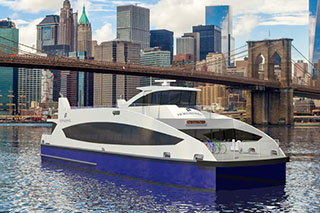Hornblower Inc. will build 18 new 149-passenger catamaran fast ferries for New York City under a contract Mayor Bill de Blasio announced this week for citywide ferry service.
In the meantime, San Francisco-based Hornblower will lease vessels it needs to serve all six routes in the ambitious plan, which will use city transit subsidies to maintain a fare of $2.75 and make the cost of ferry commuting on par with riding the subway. The system is set to start in 2017 and be fully operational the following year.
“For the price of a single subway ride, tens-of-thousands of New Yorkers are going to have a new public transit option linking them to jobs, education and opportunities across the city. It’s going to be a commute like no other: fresh air, harbor views and a fast ride on the open water,” de Blasio said in announcing the contract award. “We are selecting an operator with an incredible track record providing service in our harbor.”

Hornblower's John James Audubon on the East River in November 2015. Kirk Moore photo.
The company’s Hornblower New York division has been working the city’s waterways for a decade, operating ferries, tour boats, charters and high-end luxury yachts. With more than 450 employees, the company carries 13 million passengers annually and said it's the largest private operator in the city. Taking on the citywide ferry service will add another 155 employees, the company said.
For months New York news media reported Hornblower was the bidder favored by the de Blasio administration and the city Economic Development Corporation which developed the ferry plan. Other ferry operators pushed back hard, to no avail. Last week, New York Water Taxi warned employees it will start winding down its operations in October if Hornblower got the contract.
Among other factors, taxi operators said they cannot compete against subsidized rates on the East River crossings, which would drop from $4 to $2.75 under the city plan.
Commuter advocates are glad to see that pricing, which opens waterborne travel as an option for workers who live as far away as Rockaway in Queens – a one-hour ride to the Wall Street landing – and lower-income residents, including some 15,000 who live in public housing within half a mile of ferry landings.
“Hornblower is honored to take the helm of Mayor de Blasio's vision for a more integrated transportation network that will make commuting and connecting easier,” Hornblower CEO Terry MacRae said in a statement. “We have already begun work to deliver a ferry system by the summer of 2017 which will revolutionize the way New Yorkers work, live and play, and we are confident this new system will become a local favorite for decades to come.”
Those first routes in 2017 will originate at Rockaway, South Brooklyn and Astoria in Queens. The routes will connect:
- Rockaway to the Brooklyn Army Terminal and Wall Street
- Astoria to Roosevelt Island in the East River, Long Island City, East 34th Street and Wall Street
- South Brooklyn to Bay Ridge, Brooklyn Army Terminal, Red Hook, Brooklyn Bridge Park’s Pier 1 and Pier 6, and Wall Street, with an optional link to Governors Island
Routes from Soundview in the Bronx and Manhattan’s Lower East Side will open in 2018, for a total of 21 landings around the city. Longer term planning is under way for future routes from Coney Island and Stapleton on Staten Island.
Some $55 million in public money is going to upgrade infrastructure upgrades, including building 10 new ferry landings and rehabilitating six others. Barges will be used to support landings and are under construction now.
For subsidizing service, the city is pledging $30 million in annual operating support over six years. Based on a projection of 4.6 million annual trips, the per-trip subsidy will be $6.60, “lower than the nearly $8 per trip subsidy on the Long Island Railroad or the nearly $15 per trip subsidy for express buses,” according to de Blasio’s office. Another $10 million is set aside for startup costs including vessel upgrades and ticketing machines.





